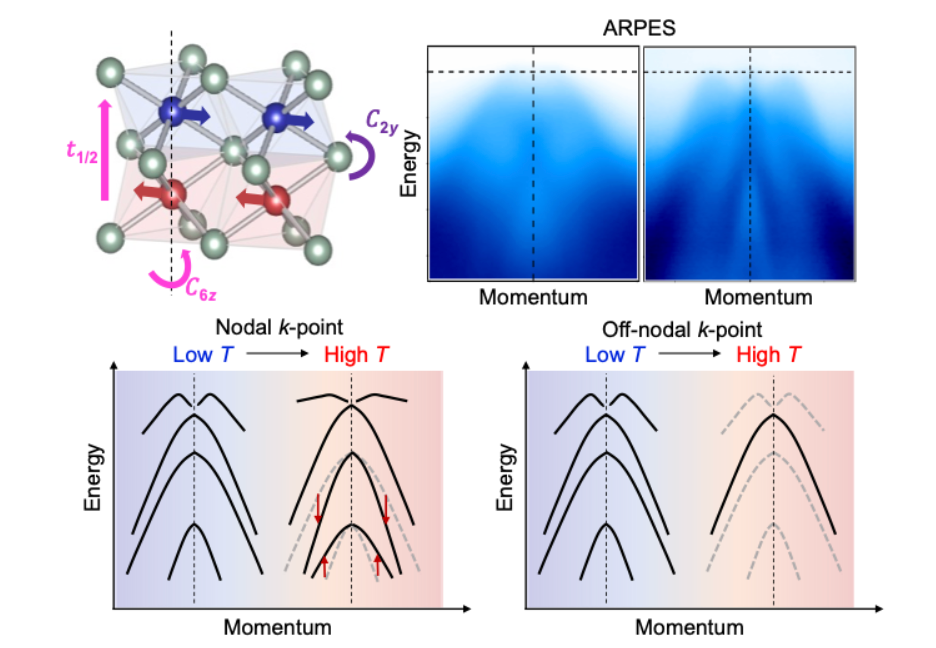Most people are familiar with ferromagnets. These materials have highly organized magnetic spins that produce a strong magnetic field that allows you to hold your grocery list on the refrigerator. While not as common, antiferromagnetism describes a material where the spins align in opposite directions and cancel each other out. So, not as helpful in the kitchen.
A multi-institutional team of researchers is exploring a newly proposed, more unusual third type of magnetism—altermagnetism. The magnetic spins in an altermagnet are in opposite directions, similar to an antiferromagnet, but the configuration of the crystal structure of the material imparts some properties of a ferromagnet.
Altermagnets are exciting because they offer a new way to control an electrical signal using spin rather than charge. Researchers could use this characteristic to design the spintronic behavior of a material to operate without generating a stray magnetic field, yielding more energy-efficient and compact devices. The team shared the results of their study in the May issue of the journal Nano Letters.
Defining the electronic structure in a thin film
The team was not entering into this quest blind. They relied on past studies that have hinted at the presence of altermagnetic behavior in manganese telluride (MnTe) and sought to characterize its comprehensive electronic structure, including full three-dimensional (3D) momentum space over a large temperature range.
The team used the molecular-beam epitaxy chamber to grow the MnTe thin film on a silicon substrate at Beamline 10.0.1 at the Advanced Light Source (ALS). They tuned the photon energy in angle-resolved photoemission spectroscopy (ARPES) to uncover the 3D view of the energy–momentum relationship of the electrons in the thin film.
While only eight atomic layers thick, the film presents an interesting candidate material to study because it undergoes a magnetic phase transition near room temperature. It also exhibits a large spin-splitting in the electronic band structure, even in the absence of net magnetization or spin-orbit coupling, a key signature of altermagnetism.
Research finds magnetic duality
“We looked at how electrons in MnTe respond when the temperature increases,” said Sung-Kwan Mo, staff scientist at ALS Beamline 10.0.1 and senior author on the study. “We found that the electrons’ behavior changes depending on the direction and speed of the electrons’ motion.”

In the nodal plane—a plane where the crystal symmetry requires electrons with up and down spins to have the same energy and momentum—the electron energy levels shift gradually as the temperature rises. According to Mo, this is what is expected when the magnetism is mediated by the electrons that can move more freely through the material.
Along the off-nodal planes, the electron energies do not shift. They simply fade away. Mo explains that this implies the magnetism arises from the collective interaction of more localized electrons.
The differences in electronic behavior at varying momenta illustrate how this thin film exhibits two kinds of magnetic behavior simultaneously. This momentum-dependent duality is very rare and provides strong evidence that altermagnetism is more complex and richer than previously believed. In addition, the identification of these properties in the MnTe thin film is especially promising for energy-efficient spintronics and quantum devices.
“The field is still in its infant stage, but a collective effort of the community will provide a more profound understanding of the nature of magnetism,” said Ji-Eun Lee, an ALS Collaborative Postdoctoral Fellow from the Max Planck POSTECH/Korea Research Initiative (MPK) and first author on the study. “Understanding how altermagnetism works could contribute to the development of next-generation memory, logic, or sensing devices that are faster and consume less power.”